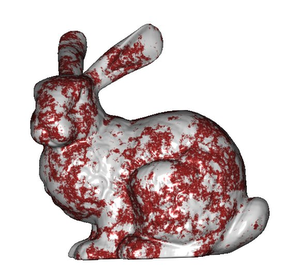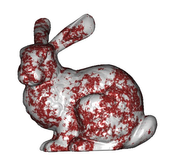Information
- Publication Type: Master Thesis
- Workgroup(s)/Project(s):
- Date: January 2005
- Note: 1
- First Supervisor:
Abstract
This thesis introduces a volume rendering technique that is conceptually based on the shearwarp factorization. The novelty in our approach is that we perform the shear transformation entirely in the frequency domain. A compensation for the direction dependent sampling distance along the viewing rays, which is present in the standard shear-warp approach, is developed. This compensation is also carried out in the frequency domain and is capable of producing freely selectable sampling distances. The accurate scaling of the volume slices is achieved by using the zero padding interpolation property. Finally, a high quality gradient estimation scheme is presented which uses the derivative theorem of the Fourier transform. Experimental trials have shown that the presented method can outperform established algorithms in the quality of the resulting images. Especially in the case when the dataset was acquired according to the sampling theorem, the presented method is capable of a perfect reconstruction of the original function.Additional Files and Images
Weblinks
No further information available.BibTeX
@mastersthesis{Artner-2005-Thesis,
title = "High-Quality Volume Rendering with Resampling in the
Frequency Domain",
author = "Martin Artner",
year = "2005",
abstract = "This thesis introduces a volume rendering technique that is
conceptually based on the shearwarp factorization. The
novelty in our approach is that we perform the shear
transformation entirely in the frequency domain. A
compensation for the direction dependent sampling distance
along the viewing rays, which is present in the standard
shear-warp approach, is developed. This compensation is also
carried out in the frequency domain and is capable of
producing freely selectable sampling distances. The accurate
scaling of the volume slices is achieved by using the zero
padding interpolation property. Finally, a high quality
gradient estimation scheme is presented which uses the
derivative theorem of the Fourier transform. Experimental
trials have shown that the presented method can outperform
established algorithms in the quality of the resulting
images. Especially in the case when the dataset was acquired
according to the sampling theorem, the presented method is
capable of a perfect reconstruction of the original
function.",
month = jan,
note = "1",
address = "Favoritenstrasse 9-11/E193-02, A-1040 Vienna, Austria",
school = "Institute of Computer Graphics and Algorithms, Vienna
University of Technology ",
URL = "https://www.cg.tuwien.ac.at/research/publications/2005/Artner-2005-Thesis/",
}

 Thesis
Thesis

